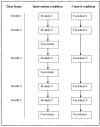Efficacy of smoking prevention program 'Smoke-free Kids': study protocol of a randomized controlled trial
- PMID: 20025727
- PMCID: PMC2805639
- DOI: 10.1186/1471-2458-9-477
Efficacy of smoking prevention program 'Smoke-free Kids': study protocol of a randomized controlled trial
Abstract
Background: A strong increase in smoking is noted especially among adolescents. In the Netherlands, about 5% of all 10-year olds, 25% of all 13-year olds and 62% of all 17-year olds report ever smoking. In the U.S., an intervention program called 'Smoke-free Kids' was developed to prevent children from smoking. The present study aims to assess the effects of this home-based smoking prevention program in the Netherlands.
Methods/design: A randomized controlled trial is conducted among 9 to 11-year old children of primary schools. Participants are randomly assigned to the intervention and control conditions. The intervention program consists of five printed activity modules designed to improve parenting skills specific to smoking prevention and parent-child communication regarding smoking. These modules will include additional sheets with communication tips. The modules for the control condition will include solely information on smoking and tobacco use.Initiation of cigarette smoking (first instance of puffing on a lighted cigarette), susceptibility to cigarette smoking, smoking-related cognitions, and anti-smoking socialization will be the outcome measures. To collect the data, telephone interviews with mothers as well as with their child will be conducted at baseline. Only the children will be examined at post-intervention follow-ups (6, 12, 24, and 36 months after the baseline).
Discussion: This study protocol describes the design of a randomized controlled trial that will evaluate the effectiveness of a home-based smoking prevention program. We expect that a significantly lower number of children will start smoking in the intervention condition compared to control condition as a direct result of this intervention. If the program is effective, it is applicable in daily live, which will facilitate implementation of the prevention protocol.
Trial registration: Netherlands Trial Register NTR1465.
Figures
Comment in
-
Family-Based Interventions in Preventing Children and Adolescents from Using Tobacco: A Systematic Review and Meta-Analysis.Acad Pediatr. 2016 Jul;16(5):419-429. doi: 10.1016/j.acap.2015.12.006. Epub 2016 Feb 15. Acad Pediatr. 2016. PMID: 26892909 Review.
References
-
- World Health Organization. Tobacco free initiative: Why is tobacco a public health priority? Geneva. 2005.
-
- STIVORO. Smoking, the hard facts: Youth. 2009. [In Dutch: Roken, de harde feiten: Jeugd 2009] Den Haag.
Publication types
MeSH terms
LinkOut - more resources
Full Text Sources
Medical



